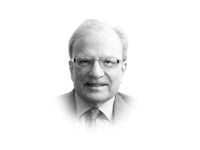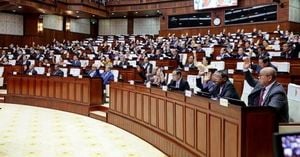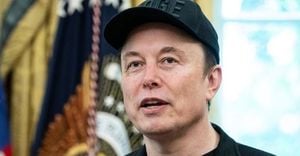In a dramatic turn on the global stage, India and China have taken bold steps to mend their strained relationship, a move that comes against the backdrop of rising tensions with the United States and shifting alliances among the world’s largest powers. The diplomatic thaw, marked by a series of agreements to boost trade, reopen travel, and ease border tensions, signals a potential reordering of Asia’s power dynamics at a time when US-India relations are under considerable stress.
The breakthrough was set in motion on August 19, 2025, when Chinese Foreign Minister Wang Yi began a pivotal two-day visit to New Delhi. According to Al Jazeera, the discussions spanned a wide range of issues: from withdrawing tens of thousands of troops amassed along the disputed Himalayan border, to increasing investment and trade flows, and even reopening crucial trading routes such as the Lipulekh Pass, Shipki La Pass, and Nathu La Pass—arteries that had been closed since the deadly 2020 border clash.
The two countries also agreed to resume direct flights—a practical step that had remained elusive since the COVID-19 pandemic and the border violence of 2020 forced travelers onto circuitous routes through Hong Kong or Singapore. The reopening of air travel is more than a symbolic gesture. It marks a tangible effort to restore normalcy in people-to-people ties, business, and tourism. Visa restrictions for tourists, businesspeople, and journalists will be lifted, and both sides pledged to improve the sharing of river data, a key issue for millions who depend on Himalayan water flows.
But why now? The timing, as reported by The New York Times and Al Jazeera, is no accident. The Trump administration’s unpredictable foreign policy, including the imposition of steep tariffs on Indian imports and penalties for India’s continued trade with Russia, has left New Delhi searching for new avenues to secure its interests. On July 29, 2025, President Trump announced a 25 percent tariff on Indian goods—an escalation that landed hard on India’s rapidly growing exports, especially in pharmaceuticals and electronics. Apple, for example, shifted significant manufacturing from China to India after US-China relations soured, only to see Indian exports targeted by the new tariffs.
“The much-touted bond nurtured through platitudes and joint appearances at stadia during rallies held in Mr. Trump's first term... when the two of them are onstage together, it is lightning,” wrote The New York Times’ Mujib Mashal, referencing the once-warm personal rapport between Trump and Indian Prime Minister Narendra Modi. Yet, as Mashal noted, “when Mr. Modi needed to lean into that relationship, he instead has had to weather a series of blows that is hurting his reputation at home.”
The sudden chill in US-India ties has forced New Delhi to recalibrate. Prime Minister Modi spoke with Russian President Vladimir Putin, reaffirming their “Special and Privileged Strategic Partnership,” and his national security adviser visited Moscow to finalize details for Putin’s planned visit to India. Meanwhile, the US-India trade talks stalled after multiple rounds, with India showing some willingness to open its protected agriculture markets—a sensitive issue that sparked major protests by Sikh farmers in 2024, leading Modi to withdraw controversial agricultural laws.
China, sensing an opening, has reportedly agreed to address India’s concerns over export curbs on fertilizers, rare earth minerals, and tunnel-boring machines—strategic goods for India’s economy. While Chinese Foreign Ministry spokesperson Mao Ning declined to confirm the details, she said, “Let me say broadly that we stand ready to strengthen dialogue and cooperation with relevant countries and regions and jointly keep global industrial and supply chains stable.”
Wang Yi’s meetings with Modi and National Security Adviser Ajit Doval paved the way for Modi’s first visit to China in seven years, scheduled for late August. After the talks, Modi posted on X (formerly Twitter), “Stable, predictable, constructive ties between India and China will contribute significantly to regional as well as global peace and prosperity.” Doval described a “new environment” of “peace and tranquillity,” acknowledging that “the setbacks that we faced in the last few years were not in our interest.” He added that “delimitation and boundary affairs” had been discussed.
China’s Foreign Ministry echoed this optimism, quoting Wang Yi as telling Doval, “the stable and healthy development of China-India relations is in the fundamental interests of the two countries’ people.”
The diplomatic pivot is not without its critics. Some in India worry that the move toward “early harvest” agreements—mini-deals that can be quickly implemented—could allow China to secure partial gains without resolving core territorial disputes. Critics have previously accused the Modi government of ceding ground to Beijing, a charge that continues to stir debate within India’s foreign policy circles.
Yet, as former Indian ambassador Nirupama Rao told The New York Times, the moment calls for “very pragmatic strategic recalibrations by New Delhi to protect its interests. India’s growing economy allows its leaders breathing room, but it is still a moment of deep introspection for the country. We have to draw our lessons from that and really focus on the national priorities and what we need to do to become stronger and more influential.”
These strategic shifts are unfolding as the broader global order faces unprecedented stress. As Shahid Javed Burki observed in The Express Tribune, “The global order constructed with considerable care by the Western leadership that won for their nations the Second World War is now under great stress. We are now witnessing the growing conflict among four large powers: the United States, China, Russia and India.” The idiosyncratic leadership styles of Trump, Modi, Xi Jinping, and Vladimir Putin only add to the complexity. Sanjaya Baru, a former adviser to Indian prime ministers, captured the sentiment: “What we have now is a US president who is a very egotistical person with a highly personalized style of leadership and an Indian prime minister who is also an egotistical person with a highly personalized style of leadership. When you have two leaders who have converted what is essentially a relationship between two nations into a relationship between individual leaders, I think this is the price that we probably are now paying.”
Looking ahead, the realignment may also reshape multilateral forums. Both India and China are set to host the BRICS summits in 2026 and 2027, respectively, a move that could strengthen their cooperation and present a united front in a rapidly changing global order. Trump, for his part, has repeatedly criticized BRICS, warning members against challenging the US dollar’s dominance.
With tariffs looming, alliances shifting, and old certainties dissolving, India’s pragmatic pivot toward China marks a significant moment in the evolving dance of global diplomacy—one that will reverberate far beyond the Himalayan passes and the corridors of power in Washington and Beijing.




